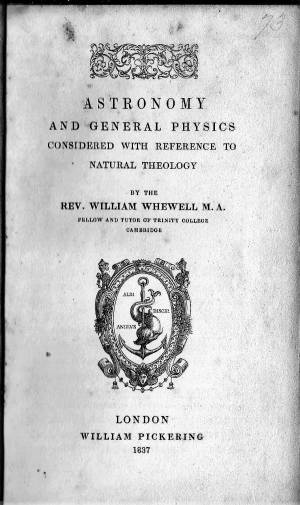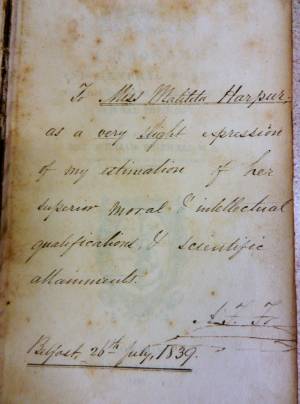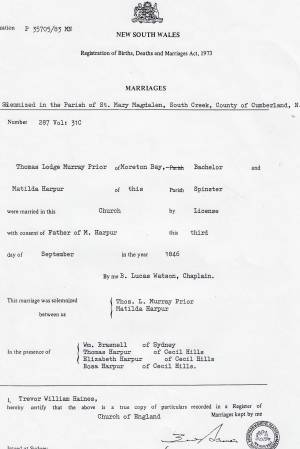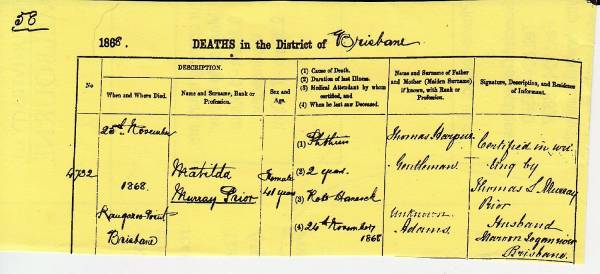This is an old revision of the document!
Matilda Murray-Prior and her children
Matilda (1827-68) was TLM-P's first wife and the second daughter of Thomas Harpur of Cecil Hills near Liverpool (now western Sydney).
 The only known photo of Matilda.1)
The only known photo of Matilda.1)
Matilda's family came from a Northern Ireland. She was born 'in the parish of Desertcreat, near Tullyhogue, south of Cookstown, a Protestant plantation town in the northern Irish county of Tyrone.' Her mother, Rose or Rosa (nee Adams) died in 1835. In after years, little was known about her: TLM-P stated 'unknown', when required to give her Christian name on his wife's death certificate (see below).2) Another son-in-law gave her name as Rose though Patricia Clarke thought it was Rosa.3) After the death of Matilda's mother, Patricia Clarke states that the family moved to Dublin. There Matilda's father married Mary Jane Speer, whose father was a Dublin solicitor.4) Before they emigrated, Matilda and her family gave their address as Lime Park, County Tyrone and College-square North, Belfast.5) To emigrate, 'They travelled to the English port of Plymouth and, on 24 June 1840, left the United Kingdom aboard the newly built barque the Lord Western under Captain Lock.6) They arrived in Sydney on 5 October 1840, a year after Matilda's future husband.
The Lord Western's passenger list7) reveals that the Harpurs sailed with 233 'bounty emigrants', that is, people who emigrated with the assistance of money from the Colonial Government. The Harpurs, like TLM-P, were 'cabin passengers', paying their own way in superior accommodation. As well as 'Miss Matilda Harpur' and her father and step-mother 'Mr. and Mrs. Harpur', there was an elder and younger brother along with two sisters: 15 year-old Thomas Harpur,8); Miss E[lizabeth] Harpur9); Miss Rosa Harpur10) and 9-year-old Master A.H. Harpur.11)
Thomas Harpur first tried farming on the Parramatta River, then settled in Cecil Hills, north-west of Liverpool.12) His and Mary Jane Harpur's daughter Emily Anne was born in 1843.13) The birth notice inserted in the paper gives scant recognition to Mary Jane: it simply states that 'On the 4th instant, the Lady of Thomas Harpur, Esq., of Cecil Hills, of a daughter'.14) Like her step-sisters Matilda and Elizabeth, Emily married and lived in Queensland.15) Matilda's step-mother, described as Mary Jane Harpur nee Speer, the widow of Thomas Harpur late of Cecil Hills, died in London in 1887. Only one offspring was mentioned: Richard Harpur of Barmundoo, Gladstone.16)
Thomas Harpur was not a success in the new colony. His granddaughter Rosa Praed was an imaginative novelist rather than reliable biographer. Nevertheless, she drew on her mother's letters when she wrote that Thomas Harpur was unsuited to the life of a colonial bushman. Rosa quoted Matilda writing to her fiancee as bemoaning that their property was plagued by drought and bushfire while “Papa, while his bush is burning and his beasts are perishing, sits in the little parlour writing poetry… He is now writing a piece on Life which is very pretty, but mama does not like his confining himself so much to the little parlour, for besides injuring his health, poetry also makes him neglect the station. But papa, she mournfully adds, was never cut out to be a bushman; he is much fonder of writing poetry than of riding after cattle.”17) Thomas Harpur's poetry appeared in a Sydney Weekly called Atlas under his pseudonyms 'Harmonides' and 'Cecil Hills', and in 1847 his major epic poem, A Land Redeemed, was published.18)
Whether because of his neglect of his property in favour of poetry or another cause, by May 1844 Thomas Harpur was bankrupt. He even had to hand over his clothes to his creditors.19) In 1846, in a flowery letter defending himself against the charge of providing 'sly grog' (home-made alcohol) and noting he was acquitted of the charge, he described himself as a 'farmer'.20) He, his wife, and two younger children had a lucky escape that year: the house caught on fire and when fighting it, a large chest was dragged from the fire, then was discovered to contain gunpowder. Thomas Harpur had brought it out 'from home', and forgotten about it! Note in this account, only two of his younger children are mentioned: had the others all left home?21) Thomas Harpur was still living at Cecil Hills in 1847.22) He died in 1848, aged 51.23)
Given her father's love of poetry and lack of desire to tackle alternative employment, it is understandable that numerous writers have assumed that Thomas was the brother of the prominent colonial poet, Charles Harpur. Additionally, Matilda also was a talented writer, though her talent was used mainly used to educate her children to appreciate English literature and history. Charles Harpur, like Matilda, was also to die of tuberculosis.24) However, a shared surname appears the only traceable family connection.25) Certainly none of those who assert that Charles and Thomas Harpur were brothers have provided any evidence of the supposed relationship. Thomas Harpur was born in Ireland in 1797, migrating to Australia in 1840; Charles Harpur was born in Australia in 1813. His parents were both convicts and married in 1814: his father, who had been a school master, was transported for highway robbery in 1800.26)
What little we know about Matilda is all positive. Her daughter Rosa recalled her as 'a wise woman and most tenderly sympathetic'.27) One piece of evidence tells us more about her: a book that belonged to her, with her name, address and a dedication as seen below ('Miss Matilda Harpur as a very slight expression of my estimation of her superior moral & intellectual qualifications & scientific attainments.'). The book was the Companion to the Bible. Intended for Bible Classes, Families, and Young Persons in General, published by the Religious Tract Society.28) It confirms that the Harpurs were Protestant with evangelical leanings, and that they lived in College Square, Belfast. It also provides evidence that Matilda Harpur was considered exceptionally bright.

 Title page and dedication of the book presented to Matilda Harpur.
Title page and dedication of the book presented to Matilda Harpur.
The (teacher's?) initials may be 'A.F. Fr.' and it is dated Belfast 26 July 1839. The book is typical of its era in its presentation of science as evidence of God's creation. It is hardly light reading, especially for a 12-year-old! Its excellent condition may be because it was treasured - but equally probably, because it was little read.
If Matilda had been a boy, what use would she have put her scientific and intellectual ability? As it was, the following year she migrated to Australia and 6 years later, on 3 September 1846, aged 18, married 26-year-old TLM-P at St. Mary Magdalene Church of England, South Creek, Cecil Hills.29)
 30)
30)
It appears that Matilda and TLM-P had been writing to each other since the year after she arrived in the colony, that is, from the time she was 13 or 14 years old.31) While the letters allowed some familiarity, TLM-Ps efforts to establish himself in the north allowed little opportunity for visits. It also meant anxiety and long silences. Rosa Praed states that one of Matilda's letters took over five months to reach TLM-P, 'and then only through his chance meeting with the person who had bought in north, when Murray-Prior was delivering a mob of bullocks to the butcher in Brisbane.' There was reason for anxiety though one of Matilda's comments suggest that her fears were based on sensationalism rather than the more prosaic reality of Aboriginal people defending their land (but not being cannibals), or the ever-present danger of accidents and illness far from help. According to Rosa, Matilda wrote in her letter that, 'I am indeed thankful to know by the sight of your handwriting at last that you have not been murdered by bushrangers or eaten by Blacks.'32) Another time, again according to Rosa, TLM-P complained about her restraint (quite understandable if her father or step-mother read her letters, as was conventional at the time). Matilda asked 'Have I not given you the best proof of my affection and confidence in consenting to share your fortunes?'33) For a ardent young man angling for a declaration of passion, it was a dampening reply.
Much to the grief of her children, Matilda died of consumption (tuberculosis)34) when she was 41 years old at their home 'Montpelier' at Kangaroo Point, Brisbane on 25 November 1868 and was buried in Brisbane Cemetery. She was not alone in suffering from tuberculosis in this pre-vaccination era: in Queensland it was the 'largest single killer of working adults throughout the colonial period', though Pacific Islanders were particularly susceptible. As well, at the time Queensland had a higher death rate from the disease than England.35) Matilda's death certificate indicates that the diagnosis was made two years before she died, shortly after the birth of her last child, Egerton.36) Grief at her loss lingered. In 1882 her widower visited Lady Bowen, the wife of the first Governor of Queensland: she 'had tears in her eyes naming Matilda. She [Matilda] was so good, so kind she had never met a more unselfish woman'. Lady Bowen shook her head at the news TLM-P had remarried 'and still more when in reply I told her I had more children'.37)
Matilda's sisters Rosa and Elizabeth Harpur visited her after her marriage and they too married Queensland squatters, both in 1854. These relatives were especially important given the small (white) settler population - Queensland only had around 30,000 settlers in 1861, and about two-thirds were men.38) Rosa Harpur married Charles Robert Haly (1816-92) and lived on Taabinga Station in the Burnett district until he was forced to sell it due to 'diseases in his sheep and the rapid spread of speargrass'. In 1882 he became police magistrate at Dalby where, from 1891, he was also clerk of Petty Sessions. He died the following year, reportedly survived by 11 of his 14 children.39) In 1881, Nora M-P mentions a 'Rosie Haly', apparently named after her mother, as someone who might help Lizzie look after the children at Maroon while Nora had her baby in Brisbane. At least Nora expected it would be Rosie Haly 'in default of anyone more interesting'.40) In 1882 TLM-P visited Captain O. G. Haly when he saw the name on an office in the army's Intelligence office, where he was visiting one of his second wife's relatives. Captain Haly had been close to Charles Haly's brother William. The brothers had migrated together to Queensland, with Captain Haly commenting that 'all the sons of the family are in Australia' - except presumably himself.41).
Matilda's other sister, Elizabeth Harpur, married William Barker of Tamrookum station.42) They had six sons and two daughters.43) In the late 1860s, the well-known poet and novelist, James Brunton Stephens, was employed as their tutor at Tamrookum.
The three Harpur sisters and their families were close, and the small European population promoted everyday interactions.44) TLM-P had business dealings with his brother-in-law Charles Haly, as a note in TLM-P's 1864 diary refers to him paying interest, and that TLM-P offered to sell him some land.45) One son of Rosa and Charles, William O'Grady Haly, also illustrates the close connections.46) 'Mr O'Grady Haly' had been superintendent at Maroon to an earlier owner of that property.47); when he died, he named his (late) uncle TLM-P as a co-trustee/executor.48) Similarly, the small circles in which they moved is illustrated by the experience of Elizabeth and William Barker. When they retired from Tamrookum, they purchased 'Nunnington', a house at Kangaroo Point, Brisbane. It was sold to them by Frederick Orme Darvell, then Registrar-General of Queensland, and Nora M-P's uncle. Nunnington was named after the Darvall family home in Yorkshire.49)
Evidence of the literary bent of Matilda and her children survive in few copies of a hand-written family magazine that they produced at Maroon and called Maroon Magazine. The children's cousins, the Barkers, and James Brunton Stephens also contributed.50) Three issues are in Rosa Praed's papers in the Oxley Library. For more click on **Magazine**. In the early years at Maroon, the family's literary activities were likely to have been enhanced by the appointment of a new manager on 3 July 186551) of William Traill. He later become a well-known journalist.
European women living in what is now Queensland had a higher number of children than their sisters in the south, a phenomenon that was strongly supported by TLM-P and other politicians, 'spurred by fears of being engulfed, both numerically and culturally by foreign invaders'.52) Matilda was exemplary in this regard: she had 12 children during her 22 years of marriage. The personal cost was high: she was pregnant for nine of the years she was married - and perhaps for longer as we don't know if she had any miscarriages or stillbirths (stillbirths were not registered in the 19th century). It is also likely that her fecundity contributed to her early death aged 41. Each time she gave birth the possibility of death was real - in 1878, for example, a pregnant woman in Queensland had 'one chance in 21 of dying in childbirth'.53) In addition, Queensland's death rate was higher than other Australian colonies, that is, it was more dangerous and unhealthy for all its population.54)

Children's health and education
Matilda had her children when her husband was struggling to establish himself. They were not wealthy at this stage and, at least for her first six births, she endured the rough isolation that characterised the life of women settlers in rural Queensland at the time. Repeated childbearing - in this age when abstinence was the only effective contraception - undermined her health. When it was combined with tuberculosis, the result was tragic for all concerned. Matilda had 12 children during 1848-66. One way of looking at this is that she was pregnant for exactly half those 18 years, during which time she also raised eight and buried four of her children. The last stages of tuberculosis leaves little doubt that the sufferer is dying, so Matilda would have known she was leaving behind motherless children. When she eventually succumbed, her 8 surviving children ranged in age from 20 to 2 years old.
Patricia Clarke asserts that Matilda and her children avoided the worst of Brisbane's summer heat by spending some summers in Hobart. Subsequently, the younger boys, Morres, Hervey, Redmond, Hugh and Egerton 'became boarders at the private, highly regarded, non-sectarian High School in Hobart'.55) The older boys attended the school too. Thomas de M. M-P was at 'Mr. Shaw's school, Brisbane' then at 'the High School, Hobart, Tasmania'.56) Similarly, Hervey M-P was reported as 'a distinguished pupil at the Ipswich Grammar School, and subsequently at the High School, Tasmania, where he gained one or two important scholarships'.57) Table Talk 58) reports that Thomas de M. M-P attended the High School in Hobart in the early 1860s, when it was run by the Rev. R. D. Poulett Harris and was a 'notable' private school attracting boys from various regions of Australia. The school's eminence lasted until 1878; it closed in 1885.59) It is not to be confused with the later state-run Hobart High School which operated 1913-66 or its prestigious rival, the Hutchins School.
Even given the school's reputation, it was a long way to go for a cool summer retreat and difficult to understand sending young boys from Queensland to school there. One consideration was the strong belief at the time that Queensland's tropical climate sapped the vitality of young Britons, resulting in a degenerate 'race'.60) If so, the fear of degeneration was gendered: only the boys were sent to school while all the girls were taught at home by governesses, Matilda and older siblings.
Given the early death and alcoholism of some of Matilda's sons, to the modern mind a question that can't be avoided is: what kind of experience did the boys have at to school in Tasmania? Was it simply because, as their eldest brother thought when he wrote to his step-mother deploring the character of Hugh and Morres, that they were too young to be sent so far from home?61). If TLM-p's plans for Egerton are any guide, the boys were sent away to school when they were around 10 years old.62) This was the age of 'spare the rod and spoil the child', when severe physical punishment was routine in schools. Yet the High School's Headmaster, the Rev. Harris, 'was charged with assaulting boys with a cane in March 1860 and June 1868, the first case being dismissed and the second settled out of court'. How brutal would the caning need to be to warrant that action in the 1860s? Is it relevant that Harris was 'prone to depression', with a daughter who was committed to a mental hospital?63) Yet again, heavy drinking by all classes was a feature of Queensland life at the time, so perhaps no other explanation is needed than the boys reflecting the social conditions around them.64) Yet doubt remains: why did the younger boys have such difficult lives? Why did their loving step-mother later find them difficult, and their father note that it thought their behaviour 'all very hard, and cut me up.'65)
 The M-P family papers includes this photo, identified on the back as Lyndhurst, New Town Road, Hobart Town, Tasmania.66) Lyndhurst was a popular name and nothing has yet been found about the homes in this photo, but does it hold a clue to why the children were sent to Hobart? Or, more probably, was it where Matilda and her children stayed when they went to Tasmania in November 1863- April 1864?67)
The M-P family papers includes this photo, identified on the back as Lyndhurst, New Town Road, Hobart Town, Tasmania.66) Lyndhurst was a popular name and nothing has yet been found about the homes in this photo, but does it hold a clue to why the children were sent to Hobart? Or, more probably, was it where Matilda and her children stayed when they went to Tasmania in November 1863- April 1864?67)
Matilda and TLMP's Children
For more details see sidebar entry.
1. Thomas de Montmorenci 27 January 1848-11 December 1902.68)
2. William Augustus, 8 August 1849 - 17 January 1850
3. Rosa Caroline, 27 March 185169) - 2 April 1935
4. Morres, 1570) May 1853 (no online record of his birth being registered has been found) - 2971) October 189772)
5. Elizabeth (Lizzie) Catherine, 29 October 185473) - 19 December 1940
6. Hervey Morres, 9 September 185674) - 1 January 188775)
7. Redmond, 26 October 185876) - 21 January 1907?77)
8. Weeta Sophia, b. 24 June 186078) - 27 July 186179)
9. Hugh, 26 July 186180) - 28 December 189581).
10. Lodge, August 186382) - September 1863.83)
11. Matilda, 2684) January 1865 - 11 May 1865.85)
12. Egerton, 5 October 186686) - 1 September 1936.